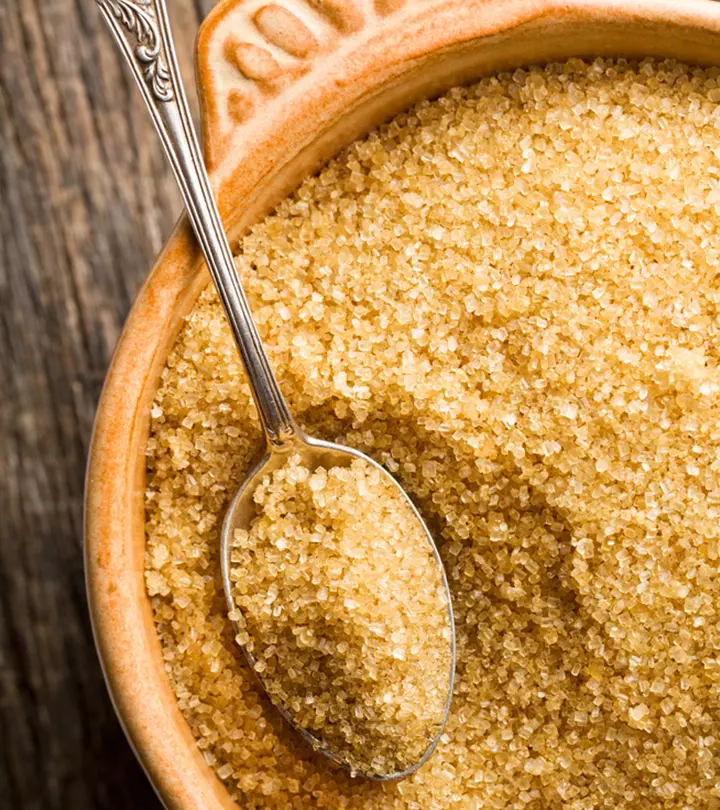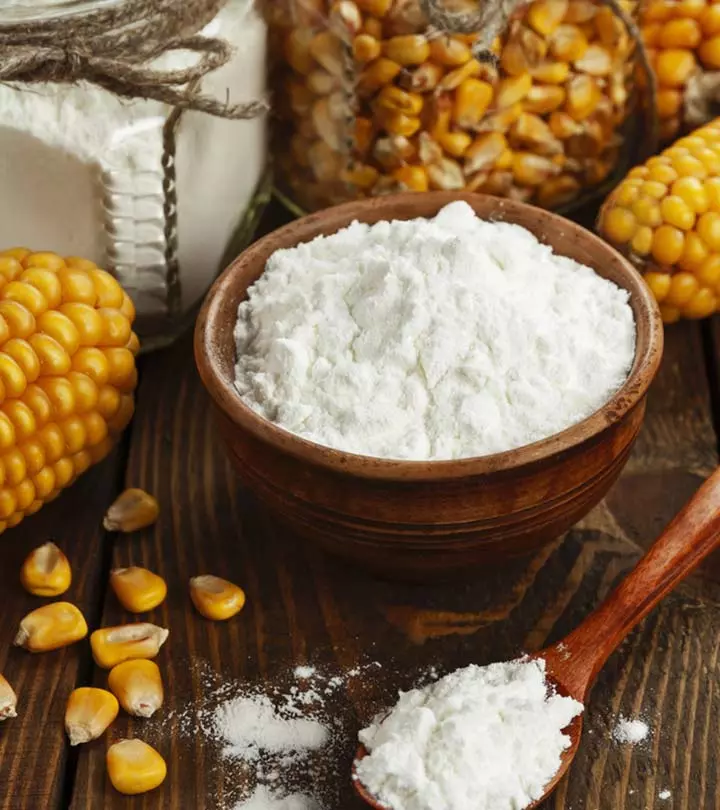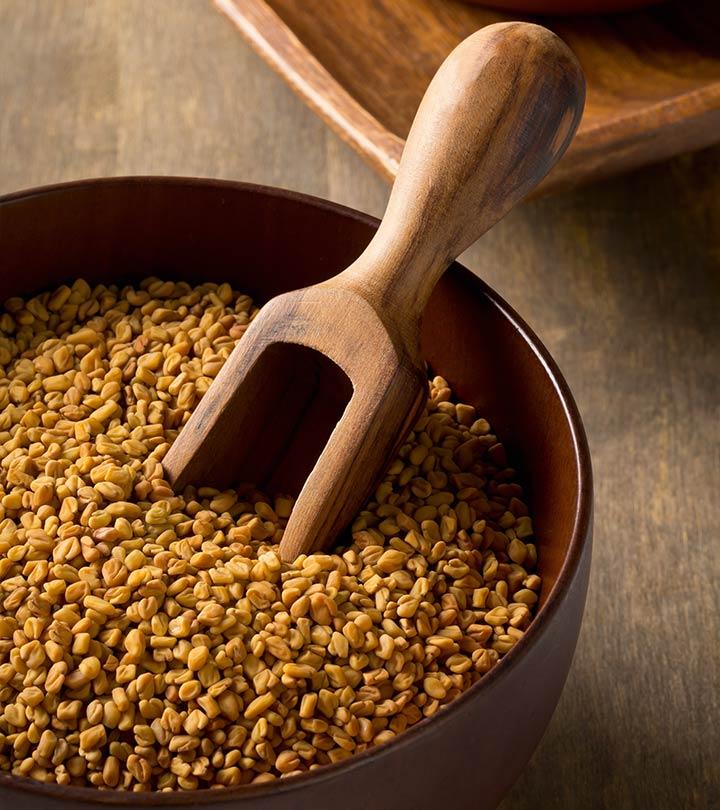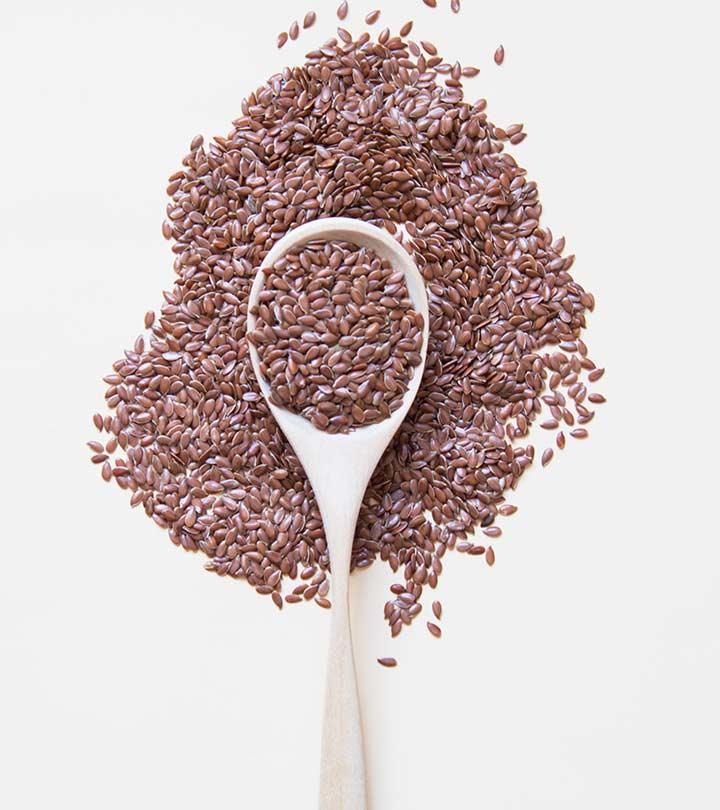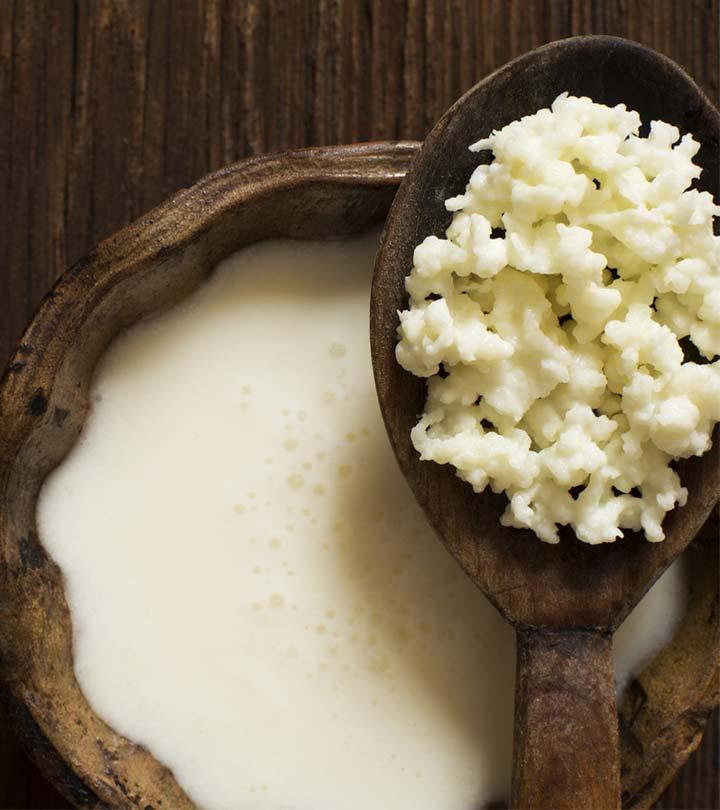Condensed Milk: Benefits, Potential Downsides, And Recipes
Looks like this yummy milky treat is a great way to put on some pounds!

Image: Shutterstock
Condensed milk is a thick, creamy viscous liquid made by removing most of the water content from milk. This milk is later sweetened with sugar and stored in sealed cans to improve its shelf-life. Due to its sweet and creamy taste, it is often added to desserts to give them a rich taste and enhance their flavor. Apart from making desserts super delicious, it also has a few health benefits. Read on to find out all about its health benefits, potential downsides, and how it can be added to your daily diet.
 Know Your Ingredient: Condensed Milk
Know Your Ingredient: Condensed MilkWhat Is It?
A thick, creamy viscous liquid, made by removing most of the water from regular milk.
What Are Its Benefits?
It improves muscle, bone, and teeth health, reduces hypertension in pregnant women, reduces inflammation, aids weight gain, and reduces fine lines and wrinkles.
Who Can Consume It?
People who are looking forward to gaining weight or improving their bone health and pregnant women.
How Often?
Consume in moderation.
Caution
Too much condensed milk may cause weight gain, sugar addiction, and increase in LDL cholesterol levels. People allergic to dairy or with diabetes and heart issues should avoid it.
In This Article
Condensed Milk Nutrition Facts
Since condensed milk is essentially made from milk, most of the nutrients from milk are still retained in its condensed form. Let us look at the nutritional values of condensed milk as per the USFDA.
Condensed Milk Nutrition Per 100g (1).
| Name | Values |
Water | 27.2g |
Energy | 321 kcal |
Protein | 7.91g |
Total Fat | 8.7g |
Carbohydrates | 54.4g |
Dietary Fiber | 0 |
Total Sugar | 54.4g |
Calcium | 284 mg |
Iron | 0.19mg |
Phosphorous | 253 mg |
Magnesium | 26mg |
Potassium | 371mg |
Sodium | 127mg |
From the table, it is quite clear that sweetened condensed milk is rich in calcium, potassium, and other minerals such as phosphorus and magnesium that are all beneficial for your health. Let’s find out how these minerals in condensed milk might translate into health benefits.
What Are The Health Benefits Of Condensed Milk?
As condensed milk is rich in calories, people who are calorie conscious may think twice about using it on a regular basis. However, that doesn’t negate some of its potential benefits when used in moderation.
- Rich In Calcium
Calcium is essential for maintaining and improving the health of your muscles, bones, and teeth (2). According to the National Institute of Health (NIH), the recommended daily average (RDA) intake of calcium for adults is 1300 mg (3). A serving of 100g of condensed milk provides nearly 20% of the recommended daily average.
Apart from improving bone health, studies suggest calcium may also be helpful in reducing hypertension during pregnancy and osteoporosisi A disorder that causes bone density loss, making them brittle and weak, increasing the risk of fractures. . It is also helpful in restoring calcium levels in postpartumi Refers to the first six weeks after childbirth, after which the pregnancy-related changes (uterus size, hormone levels) normalize. women (4).
- Ideal For Gaining Weight
For those who are underweight, eating a high-calorie and protein-rich diet is helpful in gaining weight in a healthy manner. Research suggests that this type of diet may help in improving the overall body-mass indexi A measurement of the body fat content based on a person’s height and weight to gauge the degree of fatness. (5). Since condensed milk contains 321 calories and 7.91g of protein per 100g, adding this to your diet in moderate amounts may help in gaining weight in a controlled manner.
Adding a teaspoon of sweetened condensed milk to sweeten your breakfast cereal or oatmeal is a better choice than sugar, as the former is more nutritious of the two (6). Sugar in comparison to condensed milk contains only empty calories, whereas condensed milk contains other nutrients like protein, calcium, phosphorus, and so on (1).
- May Have Anti-Inflammatory And Anti-aging Properties
Apart from being protein-rich, sweetened condensed milk also contains trace amounts of the vitamin called riboflavin, which is known to be anti-inflammatory. Riboflavin may also help in reducing the signs of aging by reducing oxidative stress caused by free radicals (7).
 Did You Know?
Did You Know?Since condensed milk is generally added as an ingredient to desserts and is not consumed in isolation or as a supplement, there is limited information available about its health benefits. In the next section let us look at some of the downsides of consuming sweetened condensed milk.
Potential Downsides Of Consuming Condensed Milk
While consuming condensed milk does have a few health benefits, it also has some downsides.
- Not Ideal For Weight Loss
Condensed milk has 321 calories per 100g, which is quite a bit. If you are looking to lose weight or maintain a calorie-deficit diet, you must avoid adding condensed milk to your diet.
- Not Ideal For People With Diabetes And Heart Issues
In addition to being rich in calories, sweetened condensed milk is rich in saturated fat that is bad for diabetes and people with cardiac issues. Studies suggest that a diet that is rich in saturated fats can lead to an increase in LDL cholesterol and insulin levels. A high level of LDL cholesterol increases the chances of cardiovascular issues. It can also increase insulin resistance thereby preventing your body from breaking down sugar that leads to type 2 diabetes (8).
- Not Ideal For Those With Lactose Intolerance
If you are allergic to dairy or are lactose intolerant, sweetened condensed milk should be avoided as it is a dairy product.
Now that you know both the benefits and downsides of consuming sweetened condensed milk, let us find out how you can add it to your diet.
How To Use It?
Adding sweetened condensed to your diet is easy. Here are a few fun ways of adding it to your diet.
- Turn It Into Caramel Sauce
One of the simplest ways to use adding condensed milk to your diet is by turning it into caramel sauce. Here’s how you do it:
- Place an unopened can of condensed milk in a pot of water and boil it for an hour.
- Use a pair of tongs to remove the can and let it cool down before opening it.
- The cooled condensed milk would have transformed into caramel sauce.
- Use this sauce to drizzle on top of ice creams and cakes.
 Trivia
Trivia- Add It To Your Coffee Or Tea
Give your coffee or tea a nice rich, creamy, and thick texture by adding a teaspoon or two of sweetened condensed milk. It is one of the best ways of making Thai-styled iced tea at home.
- Add It To Fruit Salad
If you’re in the mood for a decadent homemade fruit salad, look no further than sweetened condensed milk. Drizzle a generous amount of this delicious goodness on your fruit salad to give it that oomph and rich taste.
- Use It To Make Hot Chocolate
If you love a yummy, steaming cup of hot chocolate (cocoa), adding a teaspoon or two of sweetened condensed milk will amplify its taste. Since condensed milk is quite sweet by itself, you may want to reduce the amount of sugar that you normally add.
Apart from adding it to all of these dishes, you can have a spoonful of condensed milk straight out of the jar.
While shopping for condensed milk, you may have come across something called evaporated milk. Now that you know condensed milk is made by evaporating water from milk, how different is it from evaporated milk? Sounds a bit confusing? Fret not, all this will be cleared in the next section.
Sweetened Condensed Milk Vs. Evaporated Milk
Evaporated milk is made in the exact same way as sweetened condensed milk, except, evaporated milk is unsweetened. Similar to sweetened condensed milk, evaporated milk has a rich, creamy, and viscous texture.
Here is a quick side-by-side comparison of the nutritional profiles of both these condensed milk varieties (1), (9).
| Nutrition | Sweetened Condensed Milk | Evaporated Milk |
Water | 27.2g | NA |
Energy | 321kcal | 133kcal |
Protein | 7.91g | 6.67g |
Total Fat | 8.7g | 6.67g |
Carbohydrates | 54.4g | 10g |
Dietary Fiber | 0 | 0 |
Total Sugar | 54.4g | 10 |
Calcium | 284g | 267 mg |
Iron | 0.19mg | 0mg |
Phosphorus | 253 mg | 200mg |
Magnesium | 26mg | NA |
Potassium | 371mg | 300mg |
Sodium | 127mg | 83mg |
In comparison to sweetened condensed milk, evaporated milk has fewer calories and is lower in fat and sugar. With regards to other minerals like phosphorus, and potassium, they match up quite similarly. If you’re watching your calorie intake, consider using evaporated milk instead of condensed milk in your dessert recipes.
Speaking of recipes, here are some easy-to-make recipes using condensed milk.
Condensed Milk Recipes
First up we have an easy-to-make rolled ice cream!
1. Rolled Ice Cream
Ingredients
- 1 pint of heavy cream
- 14 ounces (1 can) of condensed milk or evaporated milk•
- A pinch of salt
- A small cup of chopped nuts and Oreo cookies (you can add strawberry jam or any flavoring of your choice)
Preparation
- In a bowl whisk heavy cream, salt, and condensed milk.
- Spread this mixture thinly on a 1/8th inch thick baking tray and evenly spread chopped nuts and Oreo cookies.
- Transfer the sheet to a freezer and let it freeze for 4-6 hours.
Serving
- Once frozen, take out the tray and set it aside.
- Use a thin metal spatula to scrape the frozen ice cream into rolls.
- Use tongs to transfer the frozen roll to a saucer and top up with fresh fruit or fruit sauce and eat immediately.
The next recipe is for magic cookie bars that you can make and store for 2-3 months.
2. Magic Cookie Bars
Ingredients
- ½ cup of melted butter or margarine
- 1½ cups of crushed graham crackers
- 14 ounces of condensed milk or evaporated milk
- 2 cups of semi-sweet chocolate chips
- 1⅓ cups of desiccated coconut
- 1 cup of assorted nuts chopped
Preparation
- Preheat the oven to 350℉ and coat a baking pan with butter or non-stick cooking spray.
- Spread the graham cracker crumbs evenly on the pan and lightly press them to form the base.
- Evenly pour condensed milk all over the graham crackers.
- Layer this with chocolate chips, desiccated coconut, and assorted nuts.
- Transfer the tray into the oven and bake for 25 minutes.
- Remove the tray from the oven and let it cool to room temperature.
- Once cooled, cut into squares and enjoy!
These simple recipes will surely leave you begging for more. Continue reading for an amazing tres leches cake recipe!
3. Tres Leches Cake
Ingredients
- 1 cup of all-purpose flour
- 1 ½ teaspoon of baking powder
- ¼ teaspoon of salt
- 4 large eggs
- 1 cup sugar
- ⅓ cup of whole milk
- 1 teaspoon of vanilla extract
- 1 can of sweetened condensed milk
- 1 can of evaporated milk
- ½ cup of whole milk
- 1 can of whipped cream
- Fresh fruits of your choice
Preparation
1. In a bowl, mix all the dry ingredients except sugar.
2. In another bowl, beat the sugar and eggs until fluffy. Add milk and vanilla extract and combine well.
3. Gradually add the dry ingredients to the beaten eggs and whisk until it is smooth.
4. Pour the batter into a pre-greased baking pan and bake in a preheated oven (350°F) for 25-30 minutes.
5. In another bowl, mix the condensed milk, evaporated milk, and whole milk together. Pour it all over the warm cake, allowing it to get soaked.
6. Refrigerate the cake for at least 2 hours.
7. Coat the cake with a layer of whipped cream.
8. Garnish with fresh fruits!
Apart from the above recipes, you also know that you can add condensed milk to almost anything you feel like. Add it to bread as a spread, Graham crackers, and more.
Infographic: Key Benefits Of Condensed Milk And How To Include It In Your Diet
Condensed milk is not only delicious but also has many health benefits. It is rich in calcium and proteins and is an excellent alternative to processed sugar. You can use condensed milk in your recipes in creative and delicious ways. Check out the infographic below to learn its key benefits and ways to use it.

Illustration: StyleCraze Design Team
In conclusion, condensed milk is made by evaporating nearly all of the water content from milk and is later sweetened with sugar. This rich, creamy liquid is used in the preparation of many desserts and sweet treats. The unsweetened version of this is called evaporated milk. Compared to sweetened condensed milk, evaporated milk has fewer calories and sugar and can be used as a direct substitute for condensed milk. You can incorporate this into your diet by adding it to your oatmeal or coffee or tea. You can even eat it as is.
Frequently Asked Questions
What is a healthy substitute for condensed milk?
Coconut cream is an excellent substitute for condensed milk.
Is condensed milk better than brown sugar?
Condensed milk may be more beneficial than brown sugar. Brown sugar has 18% more calories than condensed milk. Brown sugar contains 380 calories per 100 grams, whereas condensed milk contains 321 calories (1), (10).
Can I use yogurt instead of condensed milk?
Yes. Yogurt can be used instead of condensed milk in many recipes.
Is condensed milk real milk?
Yes. Condensed milk is prepared from cow’s milk.
Key Takeaways
- Condensed milk is rich in protein, vitamins, and minerals like calcium, potassium, and phosphorus.
- These minerals contribute to bone health and overall well-being.
- However, those with weight loss ambitions must avoid this high-calorie milk variant.
- Also, its high-carb content makes it unsuitable for consumption by those with diabetes and heart diseases.

Image: Stable Diffusion/StyleCraze Design Team
Indulge your curiosity and satisfy your sweet tooth as this fascinating video below unravels the calorie, fat, and sugar content of a beloved treat – condensed milk. Dive into the world of baking and uncover the vital role it plays in creating delicious desserts!
References
Articles on StyleCraze are backed by verified information from peer-reviewed and academic research papers, reputed organizations, research institutions, and medical associations to ensure accuracy and relevance. Read our editorial policy to learn more.
- Milk Condensed Sweetened
https://fdc.nal.usda.gov/fdc-app.html#/food-details/1097540/nutrients - Calcium and its Role in Human Body
https://www.researchgate.net/publication/274708965_Calcium_and_its_Role_in_Human_Body/ - Calcium Intake and Health
https://www.ncbi.nlm.nih.gov/labs/pmc/articles/PMC6683260/ - Calcium Intake and Health
https://www.researchgate.net/publication/334481711_Calcium_Intake_and_Health/ - Effects Of High-Calorie Supplements On Body Composition And Muscular Strength Following Resistance Training
https://www.researchgate.net/publication/11281926_Effects_of_high-calorie_supplements_on_body_composition_and_muscular_strength_following_resistance_training - Sugars Granulated
https://fdc.nal.usda.gov/fdc-app.html#/food-details/746784/nutrients - Riboflavin: The Health Benefits of a Forgotten Natural Vitamin
https://www.researchgate.net/publication/338956700_Riboflavin_The_Health_Benefits_of_a_Forgotten_Natural_Vitamin - Health Effects Of Saturated And Trans-Fatty Acid Intake In Children And Adolescents: Systematic Review And Meta-Analysis
https://www.ncbi.nlm.nih.gov/labs/pmc/articles/PMC5693282/ - Evaporated Milk
https://fdc.nal.usda.gov/fdc-app.html#/food-details/597132/nutrients - Sugars, brown
https://fdc.nal.usda.gov/fdc-app.html#/food-details/168833/nutrients
Read full bio of Dr. Pallavi Srivastava
Read full bio of Ravi Teja Tadimalla
Read full bio of Payal Karnik













